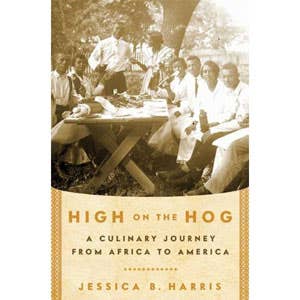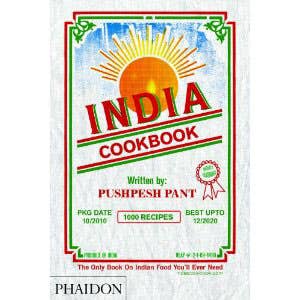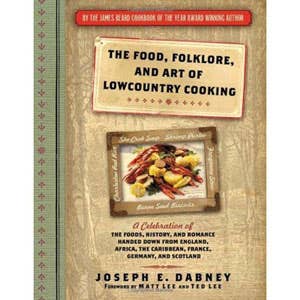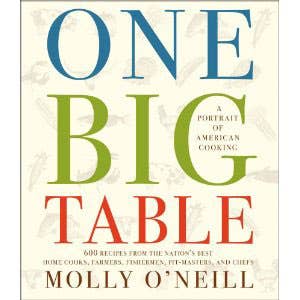Banquet of Books

Pushpesh Pant (Phaidon, 2010; $49.95)
I love Indian food. Really. I have hundreds of cookbooks on the subject. Do I cook from them all? Of course not. I pull them out in spurts, dipping into one after the next in search of the secret to a favorite dish. The trouble is that most Indian cookbooks are fairly inscrutable; they're whimsically arranged; they pair overcomplicated techniques with faint instructions, and they leave you guessing at what can be a confusing array of ingredients. Kali sabut urad dal, anyone? (That would be whole black gram beans.)
To make matters worse, your average Indian cookbook (like the standard curry joint) covers only a small part of the cuisine of northwest India, specifically the state of Punjab, with a smattering of subcontinental favorites: a spicy vindaloo from Goa, a rendition of the Kashmiri lamb stew called rogan josh. My collection of Indian cookbooks amounts to my stab at comprehensive coverage; it's my cobbled-together encyclopedia.
So, my curiosity was piqued when a friend gave me a copy of India Cookbook, which the cover bills, incredibly, as "The Only Book on Indian Food You'll Ever Need." Indeed, New Delhi—based cookbook writer Pushpesh Pant spent two decades collecting and testing recipes for the volume. A quick look-through revealed that the recipes are authentic and enticing, the photos (including 144 full-page recipe images) lush and gorgeous. Best of all, the recipes come from all over India: stir-fried cabbage with coconut from Kerala in the south as well as saffron-flavored biryani from Hyderabad in the central state of Andhra Pradesh, and samosas and other snack foods from West Bengal in the east; naan, paratha, and other breads from all over the subcontinent. I was pleased and surprised to find that one of my favorite sweets was included, a creamy, saffron-infused yogurt called Shrikhand, which hails from the western states of Maharashtra and Gujarat. Little known in the U.S., its thick texture is obtained by draining the yogurt in the refrigerator overnight, an easy and transformative technique.
While the book is chock-full of recipes (more than 1,000 in all), it is short on tips and lessons; there are few step-by-step photos or in-depth guides. But, in a way, the recipes, written in clear, digestible language, speak for themselves—aided by an introduction on the cuisines of the major regions, and, in the back, a helpful glossary of ingredients. And the section on spice mixtures and pastes—their names, ingredients, and preparations—provides as thorough a schooling in the building blocks of the cuisine as most cooks will need. India Cookbook, above all, is an inspiration and a testament to the glory of Indian cooking in all its incarnations. It's a call to the kitchen. —Todd Coleman
Joseph E. Dabney (Cumberland House, 2010; $29.99)
To call Joseph Dabney a cookbook writer isn't exactly right. Sure, his previous book, Smokehouse Ham, Spoonbread & Scuppernong Wine (Cumberland House, 1999), is full of fantastic Appalachian recipes, but they're interwoven with vivid storytelling about local traditions and characters. The same goes for Dabney's latest book, The Food, Folklore, and Art of Lowcountry Cooking, whose braided strands of history, culture, and cooking offer a fine introduction to this unique subset of Southern food.
The Lowcountry region, which stretches 200 miles from Pawley's Island, South Carolina, down to Darien, Georgia, is a land apart. Dabney, a retired PR man with a penchant for collecting oral histories, details the influences that shaped the area's cuisine: the French-inspired cooking in Charleston, Savannah, and Beaufort; the traditions of Gullah slaves who worked on the rice plantations and settled on remote barrier islands; the bounty of tidewater seafood that gave rise to beloved local dishes like shrimp and grits, frogmore stew, oyster roasts, she-crab soup, crab cakes, and more.
Chunky chapters are filled with revelations; in the one on barbecue, I learned that South Carolina's unique mustard sauce came from German colonial settlers; in the peanut chapter, I picked up a recipe for boiled peanuts in the slow cooker and learned that pinders, the local nickname for peanuts, derives from the Angolan word mpinda, and goobers, from the Central African word nguba. Dabney turned me on to recipes I've never seen before, like rice wine, which was commonly made in the area in the 1700s, and fried catfish with a crust of benne seeds (the local term for sesame seeds). Even if you're not interested in all the history, the book is a valuable recipe resource: there are three takes on chicken bog (an addictive, slow-cooked stew) and eight versions of purloo, a Lowcountry rice dish. From pimento cheese to Cheese Straws, to punch, all of the Southern party foods are represented.
On practically every page, there are Dabney's black-and-white shots of people and foods. There's commentary from food writers and historians—Matt Lee, Ted Lee, John Egerton, Nathalie Dupree—and from the region's great chefs, like Atlanta's Louis Osteen and Charleston's Robert Stehling. And there are excerpts from songs, poems, and hymns. It's this chorus of voices, as they celebrate the food and way of life of the Lowcountry, that makes Dabney's latest book such a pleasure.—Dana Bowen
Harold McGee (2010, The Penguin Press; $35)
Half a dozen years ago, when I was first living in New York City and working as a line cook, I kept a copy of food-science writer Harold McGee's On Food and Cooking by my bedside. If I had a problem in the kitchen, with emulsifying aioli, for instance, or tenderizing meat, I turned to McGee once I got home to discover what had gone wrong and how to fix it the next time it came up. I considered that book—an authoritative, accessible compendium on the science of cooking—to be my friendly guide to the kitchen.
McGee's new book is even friendlier.
A concise, Cliffs Notes—style volume with its table of contents right on the front jacket, Keys to Good Cooking calls out quick advice in bulleted, readily digestible form. Organized by tools, methods, and ingredients, with key facts set in boldface type and instructions italicized in blue, it will help you shop for vegetables, select your knives, prep work surfaces, and handle foods safely. It will teach you the basics on every technique from foaming eggs to flipping crepes, and the lessons will sink in deeper because you'll learn the simple science behind them. If you're unfamiliar with an ingredient—tepary beans, say, or farro—you can look it up in McGee. (As the book explains, the former are beans of the Southwestern U.S.—small, sweet, and quick-cooking—and the latter is emmer wheat, whose whole berries, abraded to better absorb liquids, are used to make risotto-like dishes.)
Turn to the book when you're working with a new recipe, and not only might it save you time and money, it can make you a better cook. While testing recipes for the November issue of SAVEUR, I read in its pages that the way to get a particularly crispy skin on a holiday bird is to air-dry it overnight on a rack in the refrigerator. I tried it, and the roast turkey turned out great. Then I took the book home, where I flipped it open before heating a rickety gas grill on a chilly recent Sunday and read: "Place foil on top of grills and pans to superheat them by reflecting escaping heat back onto them." Such advice might seem intuitive—a lot of good cooking is—but when you're as busy as most home cooks are nowadays, it helps to know that you can turn to McGee and be reminded of best practices. My rib eyes seared beautifully.
If On Food and Cooking was one for the reference library, the approachable Keys to Good Cooking should be kept beside your stove. As I've heard one cook say to another more than once when they've gotten into a bind on the line, "Go ask McGee."—Hunter Lewis
Molly O'Neill (Simon & Schuster, 2010; $50)
If you could choose one dish, one recipe that defines you, what would it be? That's the question author and cookbook writer Molly O'Neill poses to America in her latest book. "[American] cooks had been forgotten over the past several decades as 'cooking' morphed into 'cuisine,'" writes O'Neill.
One Big Table is her textured, joyous—and mouthwatering—rebuttal to the claim that Americans don't cook.
The author spent ten years and travelled more than 300,000 miles scouting the 800 recipes that were selected for this epic volume. The result is a profound reflection of America's delicious diversity, divided into ten recipe-crammed chapters peppered with archival images, along with profiles and occasional photos of the people (including many chefs, like Nancy Silverton and Floyd Cardoz) who contributed recipes to the book: Louise Etoch, a home cook in Arkansas who stuffs Lebanese grape leaves with lamb and mint; an Italian-Swiss woman in St. Louis, Missouri, who crafts toasted ravioli; a Mexican woman living in Ann Arbor, Michigan, who makes her own pineapple—tomatillo salsa.
Along the way, O'Neill finds time to examine the everyday foods—cream cheese, baby carrots, chocolate cake—that define the way the country eats. But her contributors themselves reveal the most about life and cuisine in America. Norma Naranjo of Ohkay Owingeh, a Native American reservation in New Mexico, uses seeds that have been passed down through generations of her Pueblo tribe to grow vegetables, which she stuffs into her tamales. "The history of our people," she says, "is in those seeds." Angela Warnick Buchdahl of Tacoma, Washington—the first Asian-American woman to be ordained a rabbi—makes brisket in a bulgogi marinade. A recipe for chicken persillade from Austin Leslie, a victim of Hurricane Katrina, is being published posthumously.
O'Neill's language is something to savor. Lobster rolls are "as unembellished as a Down Easter's speech." A clam fritter "felt like a small cumulus cloud in the hand and tasted like early morning water." Each recipe—its title including the name of the cook who provided it—is clearly written yet folksy and idiosyncratic; when I cook from the book, I feel as though I'm getting to know the person behind the dish, whether it's Ruth Eichner of Middlebury, Vermont, who prefers to use frozen berries in her pies, or Michael Mulligan of Ocala, Florida, who believes he's finally perfected the all-butter (no shortening) crust. (He freezes the butter for up to an hour. It works.)
"Michael Mulligan's All-Butter Pie Crust." "Ruth Eichner's Frozen Raspberry Pie." Barbecued clams. Vietnamese shrimp pancakes. Avocado soup. Like me, you'll want to make them all.—Gabriella Gershenson
Jessica B. Harris (Bloomsbury, 2011; $25)
Anyone interested in food history will find plenty to savor in Jessica B. Harris's latest book. In it, Harris, a culinary historian and SAVEUR contributing editor, offers a thoroughly researched chronicle of food in the lives of black people in America, from the slaves whose arrival predated the nation to today's celebrity chefs.
The centrality of sheer economics to African-American cuisine in the period of slavery is gripping. Foods native to Africa—watermelon, okra, black-eyed peas—were stowed on ships crossing the Atlantic simply because slavers sought to protect their investment: their chattel refused to eat unfamiliar European foods. Harris shows how dishes rooted in African traditions, like rice bread, stewed eggplant, and groundnut (peanut) soup, came, via Big House cooks, to take a regular place at the white Southern table. But she also refutes the canard that African-Americans were ill suited to cook anything else; more than a few 19th-century black caterers achieved renown and wealth (and created jobs for other blacks) by serving European-style specialties like filet of beef with snails, charlotte russe, and champagne jelly.
As emancipation took hold in the North in the early 1800s, many freedmen found success hawking street foods or cooking in taverns. Black cooks also followed opportunities farther afield, cooking buffalo steaks and sourdough biscuits in cowboy chuck wagons, or Dungeness crab and fresh-caught trout in Pullman railroad dining cars. In the early 20th century, as 1.5 million African-Americans migrated from the South to the Northeast, Midwest, and West, formerly regional dishes spread nationwide. The popular embrace of soul food in the 1960s recurred in the mid-'90s, when acclaim for chefs like Edna Lewis and Leah Chase brought their dishes to a wider audience—a trend that, Harris notes, continues to this day, as Marcus Samuelsson readies the Red Rooster, his new restaurant in Harlem, with a menu featuring traditional Southern black fare.
Most of the book's 23 recipes are reprinted from Harris's previous cookbooks. Among those from archival sources is a dainty dessert called Snow Eggs. One of just two known recipes credited to James Hemings, the enslaved chef whose French culinary training was sponsored by Thomas Jefferson, it evokes the complex transit by which the tastes of Africa have become part of America's heritage.—Dorothy Irwin
Keep Reading
Continue to Next Story














